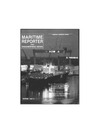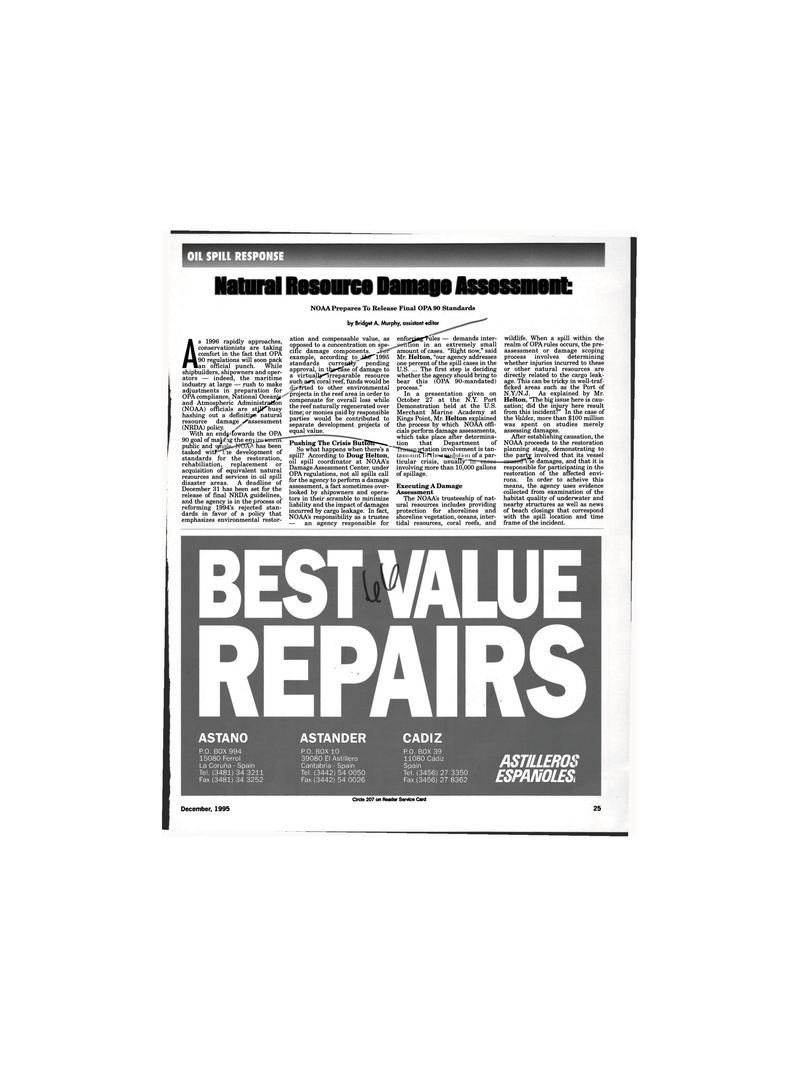
Page 23: of Maritime Reporter Magazine (December 1995)
Read this page in Pdf, Flash or Html5 edition of December 1995 Maritime Reporter Magazine
OIL SPILL RESPONSE
Natural Resource Damage Assessment
NOAA Prepares To Release Final OPA90 Standards by Bridget A. Murphy, assistant editor
As 1996 rapidly approaches, conservationists are taking comfort in the fact that OPA 90 regulations will soon pack an official punch. While shipbuilders, shipowners and oper- ators — indeed, the maritime industry at large — rush to make adjustments in preparation for
OPA compliance, National Oceanjt and Atmospheric Administration (NOAA) officials are stjtKbusy hashing out a definitive natural resource damage >^assessment (NRDA) policy.
Towards the OPA ig the enfr
With an ends 90 goal of ma]j public and tasked witJ standards for rehabiliation, amenr . has been le development of the restoration, replacement or acquisition of equivalent natural resources and services in oil spill disaster areas. A deadline of
December 31 has been set for the release of final NRDA guidelines, and the agency is in the process of reforming 1994's rejected stan- dards in favor of a policy that emphasizes environmental restor- ation and compensable value, as opposed to a concentration on spe- cific damage components. — example, according toJJhr^f"1995 standards currently pending approval, in tije^dise of damage to a virtually irreparable resource such as a coral reef, funds would be
Srted to other environmental projects in the reef area in order to compensate for overall loss while the reef naturally regenerated over time; or monies paid by responsible parties would be contributed to separate development projects of equal value.
Pushing The Crisis ButtSl _
So what happens when there's a spill? According to Doug Helton, oil spill coordinator at NOAA's
Damage Assessment Center, under
OPA regulations, not all spills call for the agency to perform a damage assessment, a fact sometimes over- looked by shipowners and opera- tors in their scramble to minimize liability and the impact of damages incurred by cargo leakage. In fact,
NOAA's responsibility as a trustee — an agency responsible for enforgjag'fules — demands inter-
Elon in an extremely small amount of cases. "Right now," said
Mr. Helton, "our agency addresses one percent of the spill cases in the
U.S. ... The first step is deciding whether the agency should bring to bear this (OPA 90-mandated) process."
In a presentation given on
October 27 at the N.Y. Port
Demonstration held at the U.S.
Merchant Marine Academy at
Kings Point, Mr. Helton explained the process by which NOAA offi- cials perform damage assessments, which take place after determina- tion that Department of station involvement is tan-
I IIIIIIIIIII lii llii'I II III|iiliiiii of a par- ticular crisis, usually- involving more than 10,000 gallons of spillage.
Executing A Damage
Assessment
The NOAA's trusteeship of nat- ural resources includes providing protection for shorelines and shoreline vegetation, oceans, inter- tidal resources, coral reefs, and wildlife. When a spill within the realm of OPA rules occurs, the pre- assessment or damage scoping process involves determining whether injuries incurred to these or other natural resources are directly related to the cargo leak- age. This can be tricky in well-traf- ficked areas such as the Port of
N.Y./N.J. As explained by Mr.
Helton, "The big issue here is cau- sation; did the injury here result from this incident?" In the case of the Valdez, more than $100 million was spent on studies merely assessing damages.
After establishing causation, the
NOAA proceeds to the restoration planning stage, demonstrating to the partff involved that its vessel le damages, and that it is responsible for participating in the restoration of the affected envi- rons. In order to acheive this means, the agency uses evidence collected from examination of the habitat quality of underwater and nearby structures as well as news of beach closings that correspond with the spill location and time frame of the incident.
ASTANO ASTANDER CADIZ
P.O. BOX 994 P.O. BOX 10 P.O. BOX 39 15080 Ferrol 39080 El Astillero 11080 Cadiz
La Coruna - Spain Cantabria - Spain Spain
Tel. (3481) 34 3211 Tel. (3442) 54 0050 Tel. (3456) 27 3350
Fax (3481) 34 3252 Fax (3442) 54 0026 Fax (3456) 27 8362
Circle 207 on Reader Service Card
ASTILLEROS
ESPAN0LES
December, 1995 25

 22
22

 24
24
